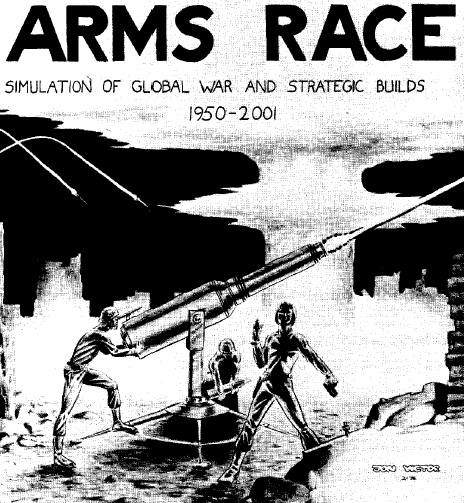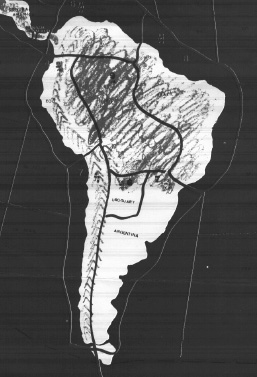Arms Race
Simulation of Global War and Strategic Builds, 1950-2001 Designed by Dave Casciano Published by Dave Casciano Co./Attack International Wargaming Association in 1976, original price $8.99 with expansion kit for fourth playerIntroduction
This is the latest installment in our purposely incomplete series of reviews of the games that sprang forth from the
fevered brow of Dave Casciano, whom
we tried to dub lastish (this is not a ‘zine
so cut it out -ed) as the “Ed Wood of
Wargaming”. Subtitled “Simulation of
Global War and Strategic Builds 1950-
2001”, this game stimulated a long-term
curiosity in me. The first and only
description of it I have ever read was a
one-paragraph item in Nicholas Palmer’s
book The Comprehensive Guide to
Board Wargaming (Sphere, 1980), as
follows:
“Arms Race has the USA and
USSR (and China in a three-player
version) slugging it out from 1950 to
2001 with armor, infantry, fighters,
bombers, spy satellites, U-2s, guerillas,
transports, subversive political groups,
secret foreign services, extensive
production rules, and the threat of
nuclear war.”
It sounded great, and I looked in vain for
it off and on for 16 years. Now I’ve
found a copy, so you don’t have to look
any further either!
the games that sprang forth from the
fevered brow of Dave Casciano, whom
we tried to dub lastish (this is not a ‘zine
so cut it out -ed) as the “Ed Wood of
Wargaming”. Subtitled “Simulation of
Global War and Strategic Builds 1950-
2001”, this game stimulated a long-term
curiosity in me. The first and only
description of it I have ever read was a
one-paragraph item in Nicholas Palmer’s
book The Comprehensive Guide to
Board Wargaming (Sphere, 1980), as
follows:
“Arms Race has the USA and
USSR (and China in a three-player
version) slugging it out from 1950 to
2001 with armor, infantry, fighters,
bombers, spy satellites, U-2s, guerillas,
transports, subversive political groups,
secret foreign services, extensive
production rules, and the threat of
nuclear war.”
It sounded great, and I looked in vain for
it off and on for 16 years. Now I’ve
found a copy, so you don’t have to look
any further either!
Players two to four (The basic game is for two or three, but an expansion kit which is actually an extra sheet of counters and a half-page scenario description allows for a Germany that survived WW II)
Period postwar
Time scale seasonal
Ground scale about 600 miles per inch
Unit scale somewhat abstract: army corps; naval fleet; air force
Components
(review copy included in the expansion kit)1 cover page with goofy ray-gun art, unit cost chart on back
1 six-page rules booklet
1 unit identification chart
3 unit production charts
1 ½ pages of scenarios
5 sheets of counters with crude artwork
2 17”x19” area-movement maps that mate to show the whole world, very crudely drawn and badly printed
Counter Manifest
Including the extra sheet of counters (black) for the expansion kit, there is a total of 1,464 single-sided counters, strip-cut on thin cardstock like the old Metagaming Microgames. There is one blank.
Major Power counters (four identical sets of 352 counters each in red, blue, orange and black, for a total of 1,408 counters).
infantry army 40
ICBM 25
surface fleet 8
mechanized army 24
ICBM complex 10
battleship fleet 2
guerrilla army 10
IRBM 11
carrier 11
short range fighter 30
MRBM 5 nuclear submarine 2
short range carrier fighter 20
ABM 6
missile submarine 2
long range fighter 16
AAM 16
conventional submarine 2
interceptor 3
MIRV 5
naval transport 5
short range bomber 4
Hard Silo 4
air transport 6
short range carrier bomber 4
nuclear blast marker 12
land transport 25
medium bomber 9
spy satellite 5
helicopter transport 4

heavy bomber 9
spy network 1
super bomber 6
political party 5
U-2 4
White units (generic self-defense/ independent countries).
infantry army 32
mechanized army 7
short range fighter 9
surface fleet 7
guerrilla army (at least 5 units needed 0 but not provided!)
blank 1
Collector’s Value
As with any Dave Casciano product, the number of copies printed cannot have been high. I obtained the review copy from a used game dealer for $25, punched, and it was the first time I had ever seen a copy offered for sale. For that matter, I never saw the game mentioned in any DCC/AIWA ad or catalog. Boone lists low, high and average costs of 15/30/22.00 at auction and 10/ 60/35.00 for sale.Player’s Value
Well, now that I’ve got it, what am I to do with it? There are some interesting notions here: the production system incorporates some long waits for units, requiring some careful planning; there is a large number of units with different effects; weapons once produced must be maintained but may be “mothballed”; there are five types of control that can be exerted on an area; and there are three types of combat (nuclear, conventional and political - the first two are diceless, relying on mutual elimination of units at different ratios depending on which types are present).However, there are numerous drawbacks. The rules are short for a game of this scope and options. They are full of annoying and jejune (now cut that out -ed) misspellings (balastic missiles; senarios; mind you don’t forefit the game) and often read like a sheaf of notes that have been typeset -- much as the map looks like a crayon drawing that had some tiny Letraset numbers sprinkled on it, and then been given the four-color treatment. There are some subsystems and options that are mentioned but never fully explained (e.g., economic aid to disputed territories; how nuclear warheads are handled; what is a fast transport). For no apparent reason there are very limited quantities of useful units in the counter mix (e.g.. only one Spy Network; three interceptors; two of each kind of submarine). The game is also totally unsuited to solitaire play because all players are supposed to secretly and simultaneously build units and plot their movements, while keeping all unit counters inverted. This system would be far too fiddly for many players, anyway. Unlike some Dave Casciano designs, I feel there is a game of sorts lurking in here somewhere that could be teased out and patched up. It was the sort of conquer-the-world game I wanted to design (but never did) when I was first getting into gaming in my teens.
Support Material
As you may have figured out by now, this game is an absolute orphan. Dave Casciano himself dropped off the face of the earth years ago.Other games on this subject
World War 3 (SPI, 1974); the Supremacy series of games (Supremacy Games, 1984-92). A less closely related game would be Strategy:1 (SPI, 1971), which introduced the idea of research and development and technological levels, and had a similarly involved unit production system.Other games by this designer
7th Cavalry; Fomalhaut II; IT; Lam Son; Littorio; Rift Trooper; Rhein Bung; War of the Star Slavers (all published by Dave Casciano Co. & AIWA).
Back to Simulacrum Vol. 4 No. 2 Table of Contents
Back to Simulacrum List of Issues
Back to MagWeb Master Magazine List
© Copyright 2002 by Steambubble Graphics
This article appears in MagWeb (Magazine Web) on the Internet World Wide Web. Other military history articles and gaming articles are available at http://www.magweb.com